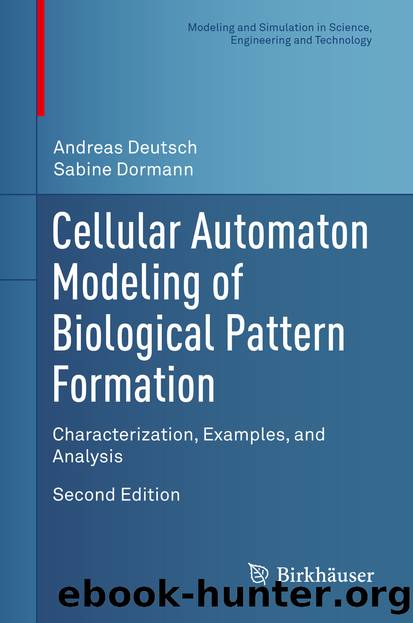Cellular Automaton Modeling of Biological Pattern Formation by Andreas Deutsch & Sabine Dormann

Author:Andreas Deutsch & Sabine Dormann
Language: eng
Format: epub
Publisher: Birkhäuser Boston, Boston, MA
Figure 10.3:Sketch of horizontal and vertical pigment pattern formation in two salamander species (Triturus alpestris (left) and Ambystoma mexicanum); cp. explanations in the text.
10.2 LGCA Model with Adhesiveand Orientational Interaction 2
A three-species LGCA is defined (ς = 3, cp. sec. 4.3, p. 76). In the LGCA, pigment cells and the extracellular matrix (ECM) are represented by oriented cells (particles) of type σ, where :
melanophore,
:
xanthophore and
:
ECM.
We assume that all cells interact but only “pigment cells” (of types σ = 1, 2) move on a two-dimensional hexagonal lattice (b = 6). We distinguish top and bottom regions of the lattice representing the neural crest and the ventral regions of the embryo, respectively. Thereby, we introduce a reference frame on the lattice. Various boundary conditions to be specified in the corresponding context will be considered.
The cells occupy lattice channels corresponding to nearest neighbor vectors c i, associated with each node r. An exclusion principle prevents two (or more) cells of the same type to inhabit the same channel. Accordingly, a state is specified by . s i σ ∈ { 0, 1} = 0 or 1 denotes the absence resp. presence of a cell (particle) of type σ in channel c i. We have .
Cell-Cell Interactions. States may change according to local interactions. States of cell type σ = 3 (ECM) are assumed to maintain their initial value and not to change in time, thereby introducing an orientational anisotropy influencing the dynamics of the moving pigment cells.
Let the number of cells of type σ corresponding to state be denoted by
Download
This site does not store any files on its server. We only index and link to content provided by other sites. Please contact the content providers to delete copyright contents if any and email us, we'll remove relevant links or contents immediately.
Algorithms of the Intelligent Web by Haralambos Marmanis;Dmitry Babenko(8519)
Test-Driven Development with Java by Alan Mellor(7353)
Data Augmentation with Python by Duc Haba(7253)
Principles of Data Fabric by Sonia Mezzetta(6996)
Learn Blender Simulations the Right Way by Stephen Pearson(6934)
Microservices with Spring Boot 3 and Spring Cloud by Magnus Larsson(6765)
RPA Solution Architect's Handbook by Sachin Sahgal(6170)
Hadoop in Practice by Alex Holmes(6028)
The Infinite Retina by Robert Scoble Irena Cronin(5870)
Jquery UI in Action : Master the concepts Of Jquery UI: A Step By Step Approach by ANMOL GOYAL(5869)
Big Data Analysis with Python by Ivan Marin(5694)
Life 3.0: Being Human in the Age of Artificial Intelligence by Tegmark Max(5398)
Pretrain Vision and Large Language Models in Python by Emily Webber(4654)
Infrastructure as Code for Beginners by Russ McKendrick(4439)
WordPress Plugin Development Cookbook by Yannick Lefebvre(4168)
Functional Programming in JavaScript by Mantyla Dan(4121)
The Age of Surveillance Capitalism by Shoshana Zuboff(4111)
Embracing Microservices Design by Ovais Mehboob Ahmed Khan Nabil Siddiqui and Timothy Oleson(3959)
Applied Machine Learning for Healthcare and Life Sciences Using AWS by Ujjwal Ratan(3931)
